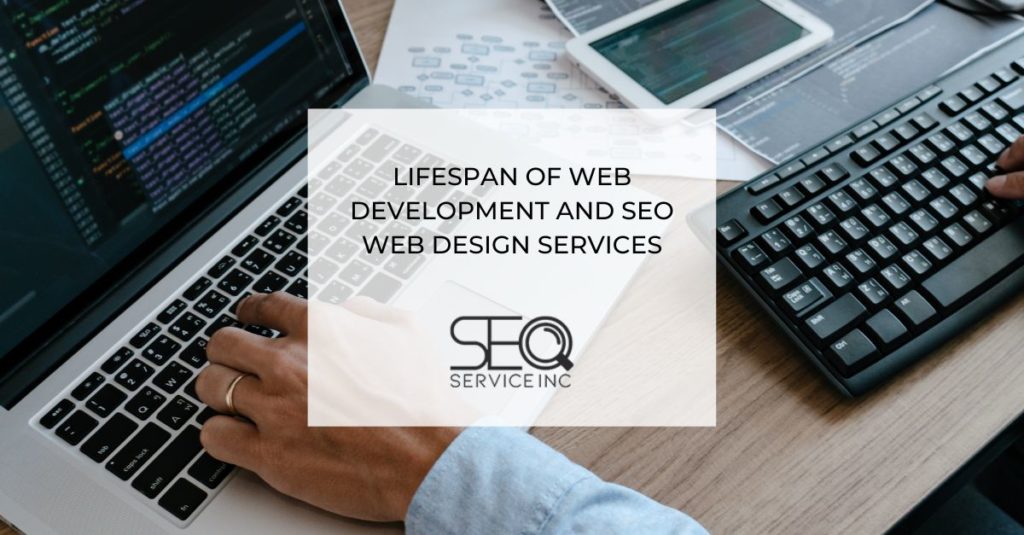
Lifespan of Web Development and SEO Web Design Services

Web development is the process of building and maintaining a website. It encompasses a wide range of tasks, and the lifespan can vary greatly depending on the type of site, the goals of a business, and the available resources. Successful websites require key elements such as captivating content, attractive visual elements, and functionality tailored to the business objectives of the organization. All of this must be wrapped and presented in effective branding, SEO, and user experience (UX) elements. Developing and maintaining a website that attracts and converts visitors requires strategic planning throughout the entire web development life cycle. Keep reading to learn all about it as well as how SEO web design services can be useful for your business.
What’s the Process of Web Development Really Like?
The web development process typically begins with the planning and designing phase. During this phase, this business will work with a web developer to determine the goals and objectives of the website, as well as the target audience.
Creating a website that accomplishes your business objectives rarely involves taking the easy road and selecting a website template. Step one requires effort to create stunning pages! Beginning web development requires substantial research and structure, including competitor analysis and, if necessary, efforts to solidify your brand.
Development Phase
Once the design is approved, the web developer will begin the development phase, which involves coding and programming the website. This can include the use of different programming languages such as HTML, CSS, and Javascript.
It is important to design your website based on your knowledge of your client’s tastes, needs, and expectations, such as e-commerce functionality and social media integration.
The back-end features of your website, like payment and customer relationship management systems, should also be carefully planned. You will receive a dashboard that allows for the addition and removal of data.
Making a Successful Website
Once development has been completed, it is now time to begin testing and optimization for performance and usability. This can include testing for compatibility across different devices and browsers.
Developing and Creating Your Content
Some people place more importance on the next step but figuring out what the website is for and what it will contain helps with the design and development process.
Is your primary objective to inform, educate, convince, sell, or influence—or some combination of these? Then, your brand identity and brand statements must govern your colour and theme choices, along with your photos, infographics, text, and other content. This is when you’ll want to plan out how keywords will enhance search engine optimization.
User Interface and Graphics
However, user experience is not solely about page aesthetics. One of the fundamental tenets of user experience is ensuring that page visitors find what they need at a glance and go to your action page (purchase, register, visit, etc.) with the fewest possible clicks.
In addition to clarity and navigation, other factors to consider at this point are page loading times and, if it’s an eCommerce site, a frictionless and stress-free checkout page.
Functionality and Ease of Use
Overusing data files and plugins is one of the worst things a web developer or site owner can do for the user experience.
Obviously, you need the appropriate functionality and information, such as product directories, to achieve your business objectives. However, large data files and an excessive number of features will slow down your website and cause you to lose leads.
Also, ensure that this website is responsive and compatible with all browsers and devices. If you have performed the initial steps with thorough research and deliberation, your website should be intuitive, streamlined, and efficient.
After Your Website’s Launch
When your site is live, does the web development lifecycle end? Absolutely not! After the website is launched, it enters the maintenance phase. During this phase, the business will work with the development team to keep the website up-to-date with the latest features and functionality, as well as to address any issues that arise.
You should have built-in analytical capabilities that allow you to routinely evaluate the success of your lead attraction and conversion. Also, consistently updating your content is essential for SEO and UX. In addition to ensuring the security and functionality of your website, program updates and other maintenance duties also ensure its upkeep.
Importantly, you must also consistently back up your website’s data and maintain the latest cyber security procedures. This means that you or a third party or SEO web design service must regularly check your website’s performance on a variety of fronts.
Get the Most Effective SEO and Web Services
If you’re preparing to embark on your next web development project, why don’t you let us handle all of the laborious tasks described above? From responsive web creation to website hosting, our professional SEO web development team can assist with your project.
Remember, the process of web design and development is dynamic and constantly evolving!
Bring your business to the next level today!. For additional information, please contact us via our official contact page or by phone.